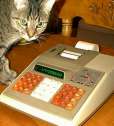Casio PB-500
| Datasheet legend
Ab/c:
Fractions calculation
AC: Alternating current BaseN: Number base calculations Card: Magnetic card storage Cmem: Continuous memory Cond: Conditional execution Const: Scientific constants Cplx: Complex number arithmetic DC: Direct current Eqlib: Equation library Exp: Exponential/log functions Fin: Financial functions Grph: Graphing capability Hyp: Hyperbolic functions Ind: Indirect addressing Intg: Numerical integration Jump: Unconditional jump (GOTO) Lbl: Program labels LCD: Liquid Crystal Display LED: Light-Emitting Diode Li-ion: Li-ion rechargeable battery Lreg: Linear regression (2-var. stats) mA: Milliamperes of current Mtrx: Matrix support NiCd: Nickel-Cadmium recharg. batt. NiMH: Nickel-metal-hydrite rech. batt. Prnt: Printer RTC: Real-time clock Sdev: Standard deviation (1-var. stats) Solv: Equation solver Subr: Subroutine call capability Symb: Symbolic computing Tape: Magnetic tape storage Trig: Trigonometric functions Units: Unit conversions VAC: Volts AC VDC: Volts DC |
| ||||||||||||||||||||||||||||||||||||||||||||||||||||||||
Casio PB-500
 Like its larger cousin, the PB-700, this Casio calculator managed to trick me: for a while, I didn't understand why my attempts to enter any command resulted in a display of SN error. Then I remembered: its two ENTER keys are not identical in functionality. The ENTER key on the numeric keypad is used to input calculator expressions for immediate evaluation; the ENTER key in the QWERTY keypad is used to enter BASIC expressions and program lines. A neat way to avoid the dreaded MODE switch I guess, but it can be a bit annoying when you don't remember this "feature"!
Like its larger cousin, the PB-700, this Casio calculator managed to trick me: for a while, I didn't understand why my attempts to enter any command resulted in a display of SN error. Then I remembered: its two ENTER keys are not identical in functionality. The ENTER key on the numeric keypad is used to input calculator expressions for immediate evaluation; the ENTER key in the QWERTY keypad is used to enter BASIC expressions and program lines. A neat way to avoid the dreaded MODE switch I guess, but it can be a bit annoying when you don't remember this "feature"!
The PB-500 is a classic style Casio BASIC pocket computer released only in the Japanese market. Its 2.8 kB main memory can be supplemented by up to two RAM cards. These cards can also be used in other Casio computers, including another Japan-only model I recently came across, the runtime-only MMC.
The PB-500's programming model is similar to that of other Casio BASIC calculators, as demonstrated here by my favorite example, the Gamma function:
10 INPUT X 20 G=1 30 IF X>5 THEN 70 40 G=G*X 50 X=X+1 60 GOTO 30 70 G=X*LOGX-X+LOG(SQR(2*PI/X)/G) 80 G=G+((((1/99/X/X-1/140)/X/X+1/105)/X/X-1/30)/X/X+1)/12/X 90 PRINT G,EXPG


